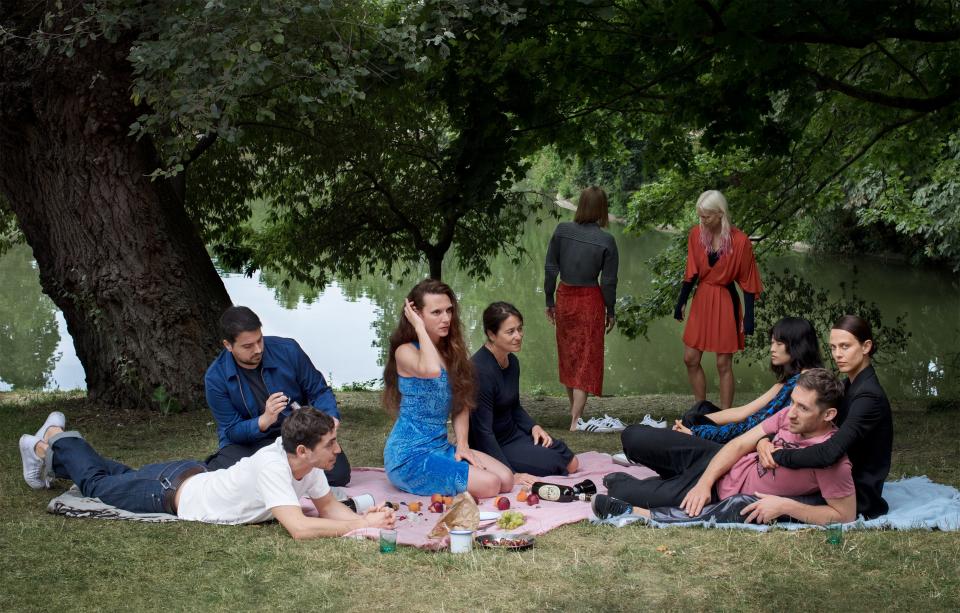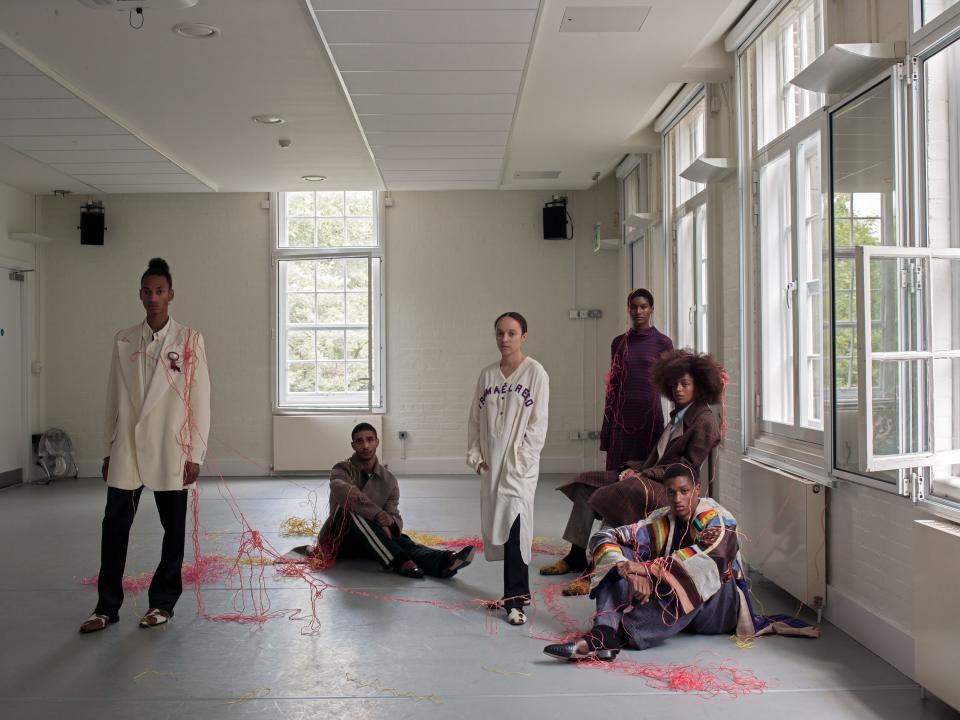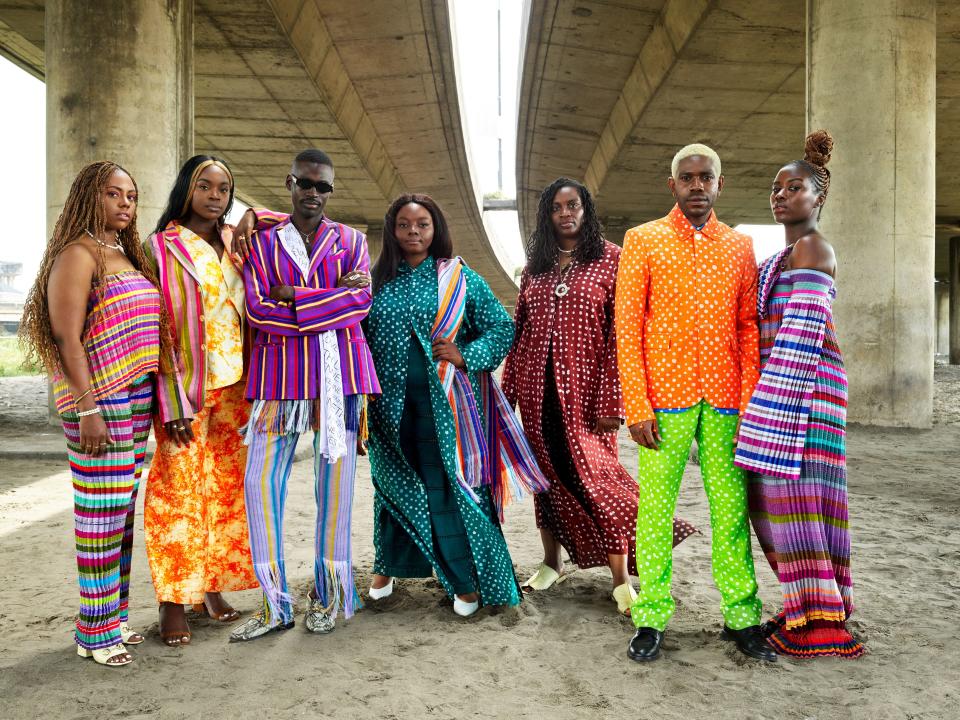5 Game-Changing Designers on the Communities Behind Their Brands
Behind a quartet of game-changing young brands—Atlein, Wales Bonner, Kenneth Ize, and Eckhaus Latta—is an inspirational web of muses and collaborators stretching across the globe.

Atlein
ANTONIN TRON 35, the designer behind the three-year-old French label Atlein, is quite comfortable with contradictions. Though he calls fashion’s claims to sustainability “fake,” his designs are far greener than those of his peers. And while he’s certainly passionate about his own brand, he’s also a passionate activist working with Extinction Rebellion in Paris—in fact, some meetings of the local chapter of the environmental organization (which has been behind recent nonviolent civilian disobedience actions on the Pont de Sully and the Trocadero) have been held in Tron’s 20th-arrondissement atelier. “When I was on the bridge getting gassed by the police, I was thinking, What am I doing here?” he says. “I reconcile it with this idea of doing things our own way—with Atlein, we carry certain values that are positive.”
Dichotomy is at the heart of his collections, too, with their persuasive mix of jersey cocktail dresses and sharp, military-strict tailoring. “I’m just instinctual,” Tron says. When he launched his label in late 2016, fashion was in peak streetwear mode, but Atlein is adamantly not a streetwear brand. “My mom restored painting in churches—that was her job,” he says. “I remember as a kid being close to the paintings, and the drape of the fabric is something I quote a lot.”
Tron crushes, sculpts, twists, and ruches material for results that are engineered as much as they are designed—most of his dresses, for example, are constructed entirely without zippers. Still, though he’s nodded to the artists John Chamberlain and Steven Parrino and the ceramicist Magdalene Odundo, he’s motivated less by themes and theatrics than by his core group of friends. “Women today don’t want logos,” he says. “They want a new kind of luxury that’s about a well-made object.”
The model Aymeline Valade is a believer. “I like how strong his clothes make you feel, while still being so feminine. They act like an armor, but with no feeling of hindrance—just bringing the right tension where it’s needed to help you have an empowered stance.”
Valade was Tron’s roommate when he worked at Balenciaga (he started under Nicolas Ghesquière and kept on with the house when Alexander Wang and then Demna Gvasalia headed it). He holds on to people, and they tend to be as passionate as he is. Romain Brau, Tron’s oldest friend, is an actor and LGBT activist. Kaisa Kinnunen and Vanja Hedberg are designer friends who are also involved in the environmental movement; Kinnunen joins him for Extinction Rebellion actions. His mother, Françoise, who now works alongside him, and his brother, Virgile, a journalist, are pictured in our portrait, as are Tron’s Atlein cofounder and partner in life Gabriele Forte; the model Chu Wong; and, of course, Valade. “Antonin surrounds himself with people that always tell him what they think for real,” she says. “They’re whole and honest—no pretenders.”
Though Tron built Atlein as responsibly and ethically as he could, he has rarely, if ever, discussed his sustainability bona fides—something about which he pulls no punches. “I’m revolted by governments’ inaction toward global warming, the destruction of ecosystems, and social injustice,” he says. “I believe in a profound change in our societies for a more fair world so that we can live in harmony with our environment.”
He’s backing up those words not just with XR actions (he and Kaisa, Romain, and his mother were involved with October’s International Rebellion) but with his clothes: Sixty percent of his fall collection was made from dead-stock materials, with zero fur or leather. He’s also working hard to cut down his company’s carbon impact.
“A lot of people have a very negative idea about fashion when it comes to the environment,” Tron explains. “I want to say with Atlein that you can create things in a respectful way.”
—Nicole Phelps

Wales Bonner
WHEN GRACE WALES BONNER established her namesake menswear brand, Wales Bonner, in 2014, she did so with a clear intention: She wanted, she says, “to reflect a broader spectrum of black masculinity—to go into depth in that study and remain committed to that approach.” That philosophy has rallied a community of like-minded individuals, many of whom have become consistent collaborators—including MJ Harper, previously a member of the Alvin Ailey and Wayne McGregor dance companies, who has choreographed many of Wales Bonner’s shows.
In February, Harper performed a daily ritual of movements over the course of four days for Wales Bonner’s multidisciplinary, multisensory exhibition “A Time for New Dreams” at London’s Serpentine Sackler Gallery—which, the designer says, “explored the ideas of mysticism, spirituality, and ritual across the black Atlantic.” (She also showed her fall 2019 collection—which featured Ben Okri reciting a poem he’d written for Wales Bonner and Ishmael Reed playing a jazz tune on a piano—at the gallery.) One notable visitor: Christian Dior artistic director Maria Grazia Chiuri, who was so enthralled that she invited Wales Bonner to reinterpret the house’s New Look silhouette for its 2020 resort collection.
“I’m interested in moments in history when men have been able to be more expressive, and I think dance is a space where you have the license to be more expressive,” Wales Bonner, 29, explains when we meet at her central London studio. Often the people who showcase her designs are friends—or the result of street castings—and benefit from the motivation and sense of camaraderie a movement director like Harper provides. The two met shortly after Wales Bonner established her brand and started working together when Harper danced with Harry Alexander of Michael Clark Company for the spring 2016 Wales Bonner show. “We were finding our voice at the same time,” she says, “and he’s been instrumental in how I think about the development of characters and movement and space when I present a collection.”
Wales Bonner’s most recent collection draws inspiration from a convergence of ideas—fragmented memories of time spent traveling around Cuba; the American historian Robert Farris Thompson’s exploration of Afro--Cuban spirituality and mambo aesthetics—and features 1940s silhouettes with military details, guayabera shirting, pleated cargo pants, and evening tuxedo jackets.
In just five short years, Wales Bonner has been awarded Emerging Menswear Designer at the British Fashion Awards, picked up an LVMH Prize for Young Fashion Designers, and been the recipient of the 2019 BFC/Vogue Designer Fashion Fund grant; in May, the Duchess of Sussex made her first public appearance after giving birth in a dress designed by Wales Bonner. Still, it’s probably more accurate to describe her as an artist—one who makes fashion the fulcrum of her work—rather than a designer. Earlier this year, she presented a devotional sound evening at Saint Peter’s Church in Manhattan, where actor Zora Casebere read a candle-lit tribute to the late American artist Terry Adkins, Laraaji gave a guided sound meditation, and Solange performed a selection of songs from her latest album.
“I’ve found my way of communicating, and that’s through clothing and creating experiences,” Wales Bonner says, citing collaboration—and the mentorship of such designers as Duro Olowu, who work outside traditional runway-show formats—as being central to her practice. “There are many ways to translate ideas and articulate feelings—through movement, through sound, through environments,” she continues. “I like to think and create holistically, and fashion is a central point for that.”
—Liam Freeman

Kenneth Ize
WHEN KENNETH IZE ARRIVED in Lagos, Nigeria, in 2015, fresh out of art school, it was something of a homecoming. Though he had spent almost all of his life in Vienna, the designer fell instantly in sync with the buzzing energy of the city where he was born. Still, getting the lay of the land in this sprawling megatropolis would require the right support system. “I really didn’t know anyone in Lagos,” says Ize, now 29, who counts his adorable dog Cosmos—an American Eskimo—as the closest thing to immediate family there. “That made it even more important for me to find my community.”
To meet like-minded people, Ize did what any other young, creative Nigerian would do: He plugged into the city’s vibrant nightlife scene. “Lagos can be a very stressful place, so going out is important for our sanity,” says Ize (it’s pronounced “ee-zay”), who faces challenges ranging from power outages and unreliable internet connectivity to road-blocking traffic with a good sense of humor. “And when we go out, we like to get dressed.”
Ize’s cohort is a stylish, well-connected bunch, part of a new generation redefining what it means to be young, gifted, and West African: There’s Faridah Folawiyo, whose mother runs Alara, the city’s must--visit, David Adjaye–designed concept store; Jomi Marcus-Bello, the mastermind behind cool skate-surf brand Waffles-ncream; Baingor Joiner, a DJ and photographer who regularly appears in Ize’s look books decked out in aso oke, the distinctive Yoruban hand-woven fabric that has become the designer’s calling card.
And yet it wasn’t until a little over a year ago, when Ize started working with a collective of craftspeople in Ilorin, a city five hours northeast of Lagos, that his fashion community was made whole. “Nigeria has such a rich tradition in textiles, but those practices are dying out,” he says. “It was only after asking elders at craft markets in Lagos that I even learned of these weavers.” And so one morning last September, Ize set off on the long drive to Ilorin. The circle of artisans he discovered there in a sleepy residential neighborhood, who had the practice of making aso oke passed down to them over generations, would begin weaving fabric for him the very same day. (Up until then, he had been relying on one master craftswoman in Lagos—“Queen Bee,” as he affectionately calls her—to fulfill the orders for his fringed, warm--weather suits, each of which requires several days of work on traditional wooden looms.)
Hand-spun with Japanese silk, the mesmerizing double-breasted men’s coats, utilitarian carpenter pants, and polka-dot batik blazers earned him a finalist spot in this year’s LVMH Prize and were revealed in their full glory on the runway at Arise Fashion Week this past April. With Naomi Campbell and Imaan Hammam on board to model his first womenswear pieces—including gently frayed palazzo pants and kaleidoscopic bandeau tops—for the show, Ize knew it was just the right moment to get the whole gang together: Instead of filling his guest list with local VIPs, he invited the circle of weavers to sit front row next to his closest friends. “I love what I do, and so much of that is based on the people who I work with,” says Ize, who hopes to set up a weaving-apprenticeship program in partnership with the collective. “I want to show the world just what we’re capable of.”
—Chioma Nnadi

Eckhaus Latta
LAST SEPTEMBER, guests arrived at the Eckhaus Latta fashion show in Brooklyn to find a vast warehouse space transformed into a hippie playroom. Rugs were splayed hither and thither, with a dozen or so kids on top of them crawling, climbing—doing kid things. Eventually, as attendees settled into their seats, the kids commenced banging on pots and shaking maracas and tambourines, creating a joyous cacophony to accompany the models’ procession along a zigzagging runway.
The daughters of New York–based designer and shop owner Maryam Nassir Zadeh played in this “baby orchestra,” as Mike Eckhaus and Zoe Latta called it; so, too, the toddler son of Mission Chinese cofounder Danny Bowien and the rambunctious two-year-old belonging to conductor Brian Chippendale, a musician friend of Latta and Eckhaus from Providence. Yet other friends could be spotted on the catwalk—designer-artist Susan Cianciolo, for instance, and models Paloma Elsesser and Camilla Deterre, who have been Eckhaus Latta mainstays since early on. Regulars at the brand’s shows have grown accustomed to such sightings: For Eckhaus, 30, and Latta, 31, fashion is a family affair.
“When Zoe and I started out, we didn’t have any money—or, to be honest, any idea of how to run a fashion business,” explains Eckhaus of his and Latta’s community-minded approach to their eight-year-old brand. “But we did have this network of talented friends who were willing to, like, play with us. That’s the great thing about being in your early 20s—all you’ve got is ideas and time.”
It’s a month out from New York Fashion Week, and Eckhaus is milling about his Lower East Side studio, waiting for a check-in call from Latta, who runs a second studio out of L.A. This unusual setup works thanks only to the umbilical connection between the two designers, who met as students at RISD and who seem to have been engaged in a nonstop conversation ever since. Though neither studied fashion at school, their desire to launch a brand stemmed from what Eckhaus describes as an “obsessive mutual curiosity” about clothes—both the way they’re made and the meaning wearers make of them in their daily lives. That sense of curiosity continues to pervade Eckhaus Latta collections even as the brand has emerged as a pillar of the New York City fashion scene: As Eckhaus puts it, he and Latta prefer to offer their clothes not as an answer but as an open-ended question: What if?
The phone rings. It’s Latta. Eckhaus quickly fills her in on his musings: “I was just talking about how naive we were when we started out,” he says. Latta laughs.
“Ignorance is bliss,” she replies.
“And we were very blissful,” Eckhaus adds.
It’s hard to remember now, but back in 2012, when the two staged their first show, “young” New York fashion was a polished thing: The standard-bearer was Alexander Wang, who adored supermodels and who wasted no time establishing his Fashion Week show as a giddy spectacle of downtown glam. Eckhaus Latta hasn’t displaced that glam, but it has carved out a space in the New York scene for an alternative, spearheading trends such as nontraditional casting; using models of all ages, shapes, ethnicities, and type; and gender neutrality. It’s a modern language of fashion that the duo speak fluently. To wit: As Latta and Eckhaus assemble spring 2020 looks, they skip nary a beat as they transfer a form-fitting top from longtime fit model May Hong (now the star of the Netflix series Tales of the City) to the strapping guy in pinstripe trousers waiting in the wings.
“They operate on their own wavelength,” says Midland Agency cofounder Rachel Chandler, who has cast the Eckhaus Latta shows since 2017. “Like, they’re very open to new ideas, but they’re also very serious about staying true to themselves and their own organic process.”
As the company has grown, Eckhaus Latta has dispensed with some of the “Let’s put on a show!” shambolics of the brand’s early outings. (Latta and Eckhaus recall one runway show staged as a kind of performance-art piece . . . where no one could see the clothes. “So that was a learning experience,” Latta notes drily.) In September, Eckhaus Latta opened a second store in L.A. to go with their small boutique in New York; as the brand has become more retail-focused, the clothes themselves have gotten snappier, too—their cult-fave denim is now a dependable breadwinner for the label, and with each succeeding season their eccentric tailoring and signature knits have elevated in both execution and tone. But Eckhaus Latta continues to be a community endeavor: Erica Sarlo, Eckhaus’s childhood best friend, has been producing the brand’s shows from the start; now she just comes attached to Susan Holland and Company, the outfit that put together state dinners during the Obama Administration. Likewise, when Eckhaus and Latta asked a handful of artist friends to create fixtures for a pop-up shop last year, it wasn’t for some fly-by-night project—it was for an installation at the Whitney. “The brand’s growing up at the same time that all the people we’ve been collaborating with are growing up, too,” Eckhaus explains. “We’re all more experienced, and there are different opportunities on the table. But the process hasn’t changed.”
“The great thing about this brand, though, is that we keep tapping into new voices and new ideas,” adds Latta. “It’s not like we’ve got some ‘life crew’—that would be really boring. Our community keeps expanding—like, I met Troye Sivan at a dinner not that long ago, and now he’s someone we talk to all the time; he’s part of our world. I wouldn’t want Eckhaus Latta to become some fixed proposition,” she continues. “So we keep an open door.”
—Maya Singer
Originally Appeared on Vogue

